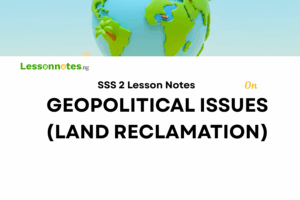World Population I SS2 Geography Lesson Note
Download Lesson Note
Lesson Notes
Topic: World Population I

Population is defined as the number of people living in an area at a particular time.
In terms of countries, China is the most populous country, followed by India, United States, Indonesia etc. In Africa, Nigeria is the most populous country with an approximate population of over 160 million people.
POPULATION CONCEPTS
- Overpopulation: Overpopulation exists when the given population of a country is considered too large for the available resources for people to enjoy the highest possible standard of living.
- Under Population: This is the type of population that is less than the available resources of a country. This means that given the existing technology of such a country; her population is considered too small to fully utilize the available resources.
- Optimum Population: This is the best type of population concept because the number of people is adequate to fully maximize the available resources of the country to attain the highest possible standard of living.
- Population Density: This is defined as the number of persons per unit area of land or square kilometometred.
Mathematically, population density = Total Population
Land Area
FACTORS OF POPULATION GROWTH
Factors responsible for world population growth can be classified broadly into physical and
human factors.
- Physical Factors:
- Climate: The favourable climate of Europe, the USA and China attracts a high population while the harsh climate of polar and desert regions does not attract a population.
- Availability of good portable water for human and agricultural purposes e.g. USA, India, Java (Indonesia) etc.
- Relief e.g. Lowlands and river valleys like the Nile Delta, Indus, and Ganges Delta (India) attract a high population while high mountains and rugged hills like the Rockies, Andes etc do not attract a population.
- Soil: Fertile soil tends to attract population.
- Presence of mineral resources e.g. Coal, Petroleum, iron ore.
- Human Factors:
- Agriculture e.g. Java, China and India practice intensive agriculture and hence have high populations.
- Religious beliefs: e.g. The Islamic religion believes in polygamy and early marriages. These encourage high populations in areas where they are practised.
- Industry e.g. Industrial regions like Pittsburg in the USA, and Ruhr in Germany tend to attract a high population.
- Immigration: The movement of people into countries like the USA, Canada and some European countries due to employment opportunities tends to increase the population in these areas.
- Good Transportation Network
- Improved Social Facilities like pipe-borne water, electricity etc and improved medical care attract a high population.






















